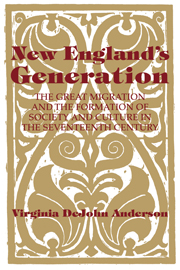 New England's Generation
New England's Generation Introduction
Published online by Cambridge University Press: 24 January 2011
Summary
Seventeenth-century America was nothing if not a collection of societies in flux. In different places at different times, Utopian schemes for settlement disintegrated upon contact with New World conditions, virulent diseases wreaked havoc upon native and European populations, harsh systems of bound labor appeared, ethnic and religious tensions spawned repeated conflict, and various groups of Europeans and Indians fought devastating wars against each other. Within this panorama of turmoil, however, New England stood apart as a region of unusual stability. No one could have predicted the eventual shape of society in Virginia, or Maryland, or Pennsylvania from either the plans of their leaders or the initial contours of development in those colonies. But in New England as nowhere else, society evolved according to patterns established in the earliest years of settlement. Only there did the framework of social and cultural institutions created by the very first generation of settlers prove to be remarkably durable. Town-based settlement, the predominance of freehold family farms, comparative economic equality, and a profoundly religious culture – these elements describe seventeenth- and eighteenth-century (and even early-nineteenth-century) New England with almost equal accuracy. Certainly up to the time of the Revolution, no inhabitant of any other region of colonial America could discern in its history anything like New England's pattern of cultural continuity.
- Type
- Chapter
- Information
- New England's GenerationThe Great Migration and the Formation of Society and Culture in the Seventeenth Century, pp. 1 - 11Publisher: Cambridge University PressPrint publication year: 1991
